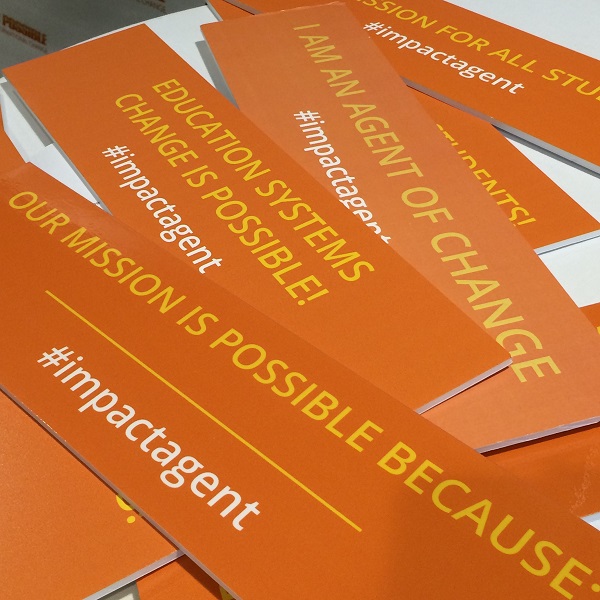I left college hungry to find solutions to tough problems and, thanks to my upbringing, I was encouraged to focus on inequity. Four years later, after a powerful experience in the Peace Corps, I was convinced that education was the key to lifting not only communities, but entire nations, out of poverty.
Hungry to learn more about this field, I came home and found a role at the largest public school in Washington, DC. The teachers I worked with were incredibly inspiring. But they consistently lamented that issues outside the school, including public policies, impeded their ability to meet the needs of the most vulnerable students. This compelled me to get a degree in public policy, an experience that introduced me to a term that seemed to capture what was needed to achieve better results at scale: systems change.
Despite my efforts to learn about systems change from texts and the nonprofit where I interned, I could not get my arms around what it really was. I knew that we needed to achieve it in education, but I became disillusioned when it was so hard to define. It seemed to be little more than a buzzword.
I was fortunate to find mentors and a role as the founding director of the StrivePartnership in Cincinnati and Northern Kentucky. There, I stopped looking for a definition and learned about systems change through experience. I had the opportunity to work with leaders across sectors—education, business, nonprofit, philanthropic, and civic—who wanted to improve educational outcomes at the population level. They were tired of taking a programmatic approach to a problem they knew was too complex for turnkey solutions.
Over the last 10 years, the StrivePartnership has sustained its commitment to moving a core group of eight outcomes and has seen consistent improvement despite a host of obstacles. The local partners have realized improvements not by starting a host of new initiatives, but by focusing their time, talent, and treasure on figuring out and spreading what works and then filling gaps with the right interventions. They are changing the system through what we now call collective impact.
Due to the overwhelming interest in collective impact and the results in Cincinnati, I have spent the last five years leading the growth of the national StriveTogether Cradle to Career Network. Today 65 communities within the network are using a common methodology to improve a core set of six educational outcome areas, ranging from kindergarten readiness to degree/certification completion. This methodology is drawn not just from the flagship partnership in Cincinnati/Northern Kentucky, but from the commitment and creativity of leaders across the country.
In essence, we’re working to define how to achieve the holy grail of systems change. There’s no cookie-cutter approach that works for everyone, but rather a general framework that respects local context and helps communities face the technical and adaptive challenges to moving outcomes at scale.
Though the definition remains elusive to this day, I’ve had a decade to reflect on what I believe it takes to achieve systems change, and a few key insights have emerged:
- Partners across sectors must define the common outcomes they will all hold themselves publicly accountable for improving.They must set clear, time-limited targets; be transparent about what is working; and be willing to “fail forward” when they make mistakes. As they do this, the partners will build the trust needed to do whatever is necessary to improve the metrics that define their collective success.
- Three integrated data sets are needed to make sense of what actions must be taken to improve outcomes at scale: local programmatic data, community expertise and voice, and national research.Partners must start by looking at local, programmatic data to determine what works. Without looking at this local data, ideology related to “education reform” will rule the day. Local experts—from academics to parents and students—need to work together to make sense of the quantitative data and contextualize it based on their experience on the ground. Finally, their conclusions should be vetted against national research to assess feasibility.
- There must be a clear understanding that success is not determined by what they do in a meeting, but what they do between meetings.The greatest fallacy of the collective impact movement is that it is about people meeting and agreeing to launch new programs or initiatives together. It actually depends on people changing their behavior each and every daybased on what their analysis of the data tells them will actually move the metrics they are holding themselves accountable for improving.
It’s this last point that is really so critical for making sure systems change does not remain a buzzword. Terms like “system”—or even the “collective” in collective impact—let individuals off the hook. We must break these big ideas down to the fundamental reality that success comes down to people—investors, practitioners, and policymakers—who work to improve the lives of children and families by changing what they do to achieve shared goals. As Kristin Schubert of Robert Wood Johnson Foundation said, “It seems to me that systems are made of people. So if people change, the systems change.”
The good news: when we embrace this reality, systems really can change. This is evident by the tangible results communities are seeing around specific outcomes in places like Memphis, Dallas, Milwaukee and more. And one day, whatever we choose to call it, this change will lead to the success of every child, cradle to career.
Jeff Edmondson is currently managing director of StriveTogether and formerly served as the founding executive director of the StrivePartnership in Cincinnati and Northern Kentucky, a partnership of postsecondary, K–12, business, philanthropic, nonprofit, and civic organizations aimed at increasing education outcomes for students throughout the region.
Republished with permission by Jeff Edmondson

